 |
European Planetary Science Congress 2012
IFEMA-Feria de Madrid
23 – 28 September 2012, Madrid, Spain |
 |
|
AM2 Amateur contribution to the advancement of planetary science |
| Convener: Marc Delcroix | Co-Conveners: Ricardo Hueso , Apostolos Christou , Jeremie Vaubaillon , Francois Colas |
|
Oral Program
/ Thu, 27 Sep, 09:00–12:30
/ Room Mercury
Poster Program
/ Attendance Thu, 27 Sep, 18:15–19:45
/ Poster Area
|
Amateur astronomy has evolved dramatically over the last years. A motivated amateur, with his/her backyard instrument and adequate processing software is nowadays capable of producing high resolution planetary images in different wavelengths which are better than what professional observatories could produce 15 years ago, follow star occultations by giant planets' atmospheres or exoplanets transits. Other dedicated amateurs use dedicated cameras or radio-antennas to provide a continuous coverage of the sky for detecting meteors.
Hundredths of regular observers are sharing their work, providing a very good coverage of the main visible planets (Jupiter, Saturn, Mars and Venus) which is very valuable at a time when it is more and more difficult for professionals to access to professional resources focused on other areas of research. Additionally, these networks of amateur observers can react immediately when triggered by a new event occurring on a solar system object requiring observations.
Moreover, some of the advanced amateur astronomers analyze this data to derive analysis which proves to match research criteria and needs, in several areas like planetary meteorology of Jupiter and Saturn, meteoroid or bolide impacts in Jupiter and Venus studies leading regularly to strong collaborations with professionals with an increasing number of published results in scientific peer journals.
This session will showcase results from amateur astronomers, working either by themselves or in collaboration with members of the professional community. In addition, members from both communities will be invited to share their experiences of pro-am partnerships and offer suggestions on how these should evolve in the future.
| Public information: |
Amateur astronomy has evolved dramatically over the last years. A motivated amateur, with his/her backyard instrument and adequate processing software is nowadays capable of producing high resolution planetary images in different wavelengths which are better than what professional observatories could produce 15 years ago, follow star occultations by giant planets' atmospheres or exoplanets transits. Other dedicated amateurs use dedicated cameras or radio-antennas to provide a continuous coverage of the sky for detecting meteors. Hundredths of regular observers are sharing their work, providing a very good coverage of the main visible planets (Jupiter, Saturn, Mars and Venus) which is very valuable at a time when it is more and more difficult for professionals to access to professional resources focused on other areas of research. Additionally, these networks of amateur observers can react immediately when triggered by a new event occurring on a solar system object requiring observations. Moreover, some of the advanced amateur astronomers analyze this data to derive analysis which proves to match research criteria and needs, in several areas like planetary meteorology of Jupiter and Saturn, meteoroid or bolide impacts in Jupiter and Venus studies leading regularly to strong collaborations with professionals with an increasing number of published results in scientific peer journals. This session will showcase results from amateur astronomers, working either by themselves or in collaboration with members of the professional community. In addition, members from both communities will be invited to share their experiences of pro-am partnerships and offer suggestions on how these should evolve in the future. |

